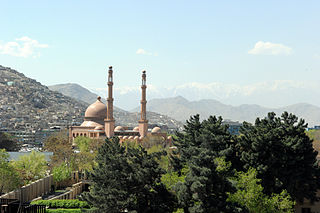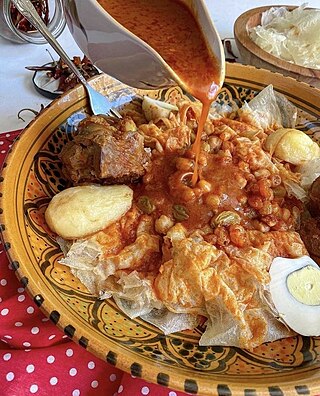Notes, references and sources
Notes
Related Research Articles

Scotch broth is a soup originating in Scotland. The principal ingredients are usually barley, stewing or braising cuts of lamb, mutton or beef, root vegetables, and dried pulses. Cabbage and leeks are often added shortly before serving to preserve their texture, colour and flavours. The proportions and ingredients vary according to the recipe or availability. Scotch broth has been sold ready-prepared in tins for many years.

Lancashire hotpot is a stew originating in Lancashire in the North West of England. It consists of lamb or mutton and onion, topped with sliced potatoes and slowly baked in a pot at a low heat.

Goulash is a soup or stew of meat and vegetables seasoned with paprika and other spices. Originating in Hungary, goulash is a common meal predominantly eaten in Central Europe but also in other parts of Europe. It is one of the national dishes of Hungary and a symbol of the country.

Gulyásleves, is a Hungarian soup, made of beef, vegetables, ground paprika and other spices. It originates from a dish cooked by the cattlemen, who tended their herds in the Great Hungarian Plain. These Hungarian cowboys often camped out with their cattle days away from populated areas, so they had to make their food from ingredients they could carry with themselves, and this food had to be cooked in the one available portable cauldron over an open fire.

Irish stew or Stobhach is a stew from Ireland that is traditionally made with root vegetables and lamb or mutton, but also commonly with beef. As in all traditional folk dishes, the exact recipe is not consistent from time to time or place to place. Basic ingredients include lamb, or mutton, as well as potatoes, onions, and parsley. It may sometimes also include carrots. Irish stew is also made with kid. Irish stew is considered a national dish of Ireland.
Irish stew is a celebrated Irish dish, yet its composition is a matter of dispute. Purists maintain that the only acceptable and traditional ingredients are neck mutton chops or kid, potatoes, onions, and water. Others would add such items as carrots, turnips, and pearl barley; but the purists maintain that they spoil the true flavour of the dish. The ingredients are boiled and simmered slowly for up to two hours. Salt can be added before or after the cooking. Mutton was the dominant ingredient because the economic importance of sheep lay in their wool and milk produce, and this ensured that only old or economically non-viable animals ended up in the cooking pot, where they needed hours of slow cooking. Irish stew is the product of a culinary tradition that relied almost exclusively on cooking over an open fire. It seems that Irish stew was recognised as early as about 1800.

Hutspot (Dutch), hochepot (French), or hotchpotch (English), is a dish of boiled and mashed potatoes, carrots, and onions with a long history in traditional Dutch cuisine. Hutspot is also found in the Indonesian cuisine due to their colonial ties.
Hodgepodge or hotchpotch describes a confused or disorderly mass or collection of things; a "mess" or a "jumble".

The cuisine of Senegal is a West African cuisine that derives from the nation's many ethnic groups, the largest being the Wolof and is French influenced. Islam, which first embraced the region in the 11th century, also plays a role in the cuisine. Senegal was a colony of France until 1960. From the time of its colonization, emigrants have brought Senegalese cuisine to many other regions.

Afghan cuisine is influenced by Persian, Central Asian, and South Asian cuisines due to Afghanistan's close proximity and cultural ties. The cuisine is halal and mainly based on mutton, beef, poultry and fish with rice and Afghan bread. Accompanying these are common vegetables and dairy products, such as milk, yogurt, whey, and fresh and dried fruits such as apples, apricots, grapes, bananas, oranges, plums, pomegranates, sweet melons, and raisins. The diet of most Afghans revolves around rice-based dishes, while various forms of naan are consumed with most meals. Tea is generally consumed daily in large quantities, and is a major part of hospitality. The culinary specialties reflect the nation's ethnic and geographic diversity. The national dish of Afghanistan is Kabuli palaw, a rice dish cooked with raisins, carrots, nuts, and lamb or beef.

Tunisian cuisine, the cuisine of Tunisia, consists of the cooking traditions, ingredients, recipes and techniques developed in Tunisia since antiquity. It is mainly a blend of Mediterranean and native Punic-Berber cuisine. Historically, Tunisian cuisine witnessed influence and exchanges with many cultures and nations like Italians, Andalusians, French and Arabs.

A potée is a French culinary term which, in general, refers to any preparation cooked in an earthenware pot. More specifically, it refers to a soup or stew made of pork and vegetables, most frequently, cabbage and potatoes of which choucroute is the most characteristic.

Puchero is a type of stew originally from Spain, prepared in Yucatán, Mexico, Argentina, Paraguay, Uruguay, Perú, south of Brazil, the Philippines, and Spain, specifically the autonomous communities of Andalusia and the Canary Islands. The Spanish word "puchero" originally meant an earthenware pot, before being extended to mean any vessel, and then the dish cooked in it.

Chakhchoukha or chekhechoukha is a traditional Algerian dish made from torn or rolled pieces of cooked semolina dough that are served in a flavorful tomato-based sauce. The dish consists of small pieces of rougag mixed with marqa, a tomato stew. The dish is typically made by boiling the semolina dough in salted water until it is cooked and then rolling it into small balls or tearing it into bite-sized pieces.

A stew is a combination of solid food ingredients that have been cooked in liquid and served in the resultant gravy. Ingredients can include any combination of vegetables and may include meat, especially tougher meats suitable for slow-cooking, such as beef, pork, venison, rabbit, lamb, poultry, sausages, and seafood. While water can be used as the stew-cooking liquid, stock is also common. A small amount of red wine or other alcohol is sometimes added for flavour. Seasonings and flavourings may also be added. Stews are typically cooked at a relatively low temperature, allowing flavours to mingle.

The hochepot is a stew eaten in the Nord-Pas-de-Calais region of France, and in Flanders and Hainaut in Belgium. Its origins go back to the Middle Ages and its first known recipes are in the Manuscript of Sion, the oldest treatise of cooking written in French around the 13th century. Although almost the same word is used in both Dutch and French, it has nothing to do with Dutch hutspot which is a dish made from mashed potato.
China chilo is a dish of stewed mutton from 19th-century English cuisine. Stewed with onions, peas and lettuce, the mutton is served in a dish surrounded by a border of rice. Scholars believe the term China in the name alludes to this oriental ingredient, but the meaning of the term chilo remains a mystery. The dish is said to be based on a Chinese dish that 19th-century sailors described upon their return from the China Seas. Food historians speculate whether creative Victorian cooks substituted lettuce for bok choy and peas for bean sprouts.

Aush jushpare is a type of aush, commonly cooked in Khorasan, Gonabad, Ferdous and Sabzevar in Iran. It is similar to the Chinese jiaozi. Historian Bayhaqi (-1077) mentioned about Aush Jushpare in his book "Tarikh-i Bayhaqi". Aush Jushpare is one of the oldest Aush, but since it takes a lot of time for preparation, it is not commonly eaten now. It is rather a dish of hospitality, which people eat on the occasion of special gatherings or festivals. Traditional guest house restaurant serves Aush Jushpare as local specialty. Aush Jushpare was registered as intangible heritage of Iran on 5 January 2021.
References
- 1 2 3 4 "hodge-podge", Oxford English Dictionary. Retrieved 1 February 2021 (subscription required)
- ↑ Warner, pp. 9, 40, and 57
- ↑ Markham, Gervase (1623). Country contentments, or The English huswife. Containing the inward and outward vertues which ought to be in a compleate woman. As her skill in physicke, surgerie, ... Wellcome Library. London : J. Beale for R. Jackson.
- ↑ Sikkel, p. 23
- ↑ Glasse, p. 97
- ↑ Cole, pp. 75, 139, and 227
- ↑ Beeton, pp. 97 and 319
- ↑ Croly, p. 33
- ↑ Davidson, p. 389
- ↑ Dods, pp. 50–51
- ↑ "American Cookery". 29. 1924.
{{cite journal}}: Cite journal requires|journal=(help) - ↑ Smith, p. 180
- ↑ Poulson, p. 35
- ↑ Newman, p. 56
- ↑ Traditional Maritime Hodge Podge", All Recipes. Retrieved 1 February 2021
- ↑ "Hodge Podge – A Vegetarian Delight in Nova Scotia", Bacon Is Magic. Retrieved 1 February 2021
Sources
- Beeton, Isabella (2006) [1861]. Mrs Beeton's Household Management. Ware, Herts: Wordsworth. ISBN 978-1-84022-268-5.
- Croly, J. C. (1878). Jennie June's American Cookery Book. New York: American News Company. OCLC 1047393452.
- Davidson, Alan (1999). "Hotchpotch". The Oxford Companion to Food. Oxford: Oxford University Press. ISBN 978-0-19-211579-9.
- Dods, Margaret (1826). The Cook and Housewife's Manual. Edinburgh: Bell and Bradfute and Oliver and Boyd. OCLC 939946524.
- Newman, Paul (1985). Newman's Own Cookbook. Chicago: Contemporary Books. OCLC 1036772519.
- Poulson, Joan (1979). Yorkshire Cookery. London: Batsford. ISBN 978-0-7134-0142-4.
- Sikkel, Manon (2003). Dutch Cooking. Haarlem: Becht. ISBN 978-90-230-1127-9.
- Warner, Richard (1791). Antiquitates Culinariæ; or Curious Tracts Relating to the Culinary Affairs of the Old English. London: R. Blamire. OCLC 1155406057.